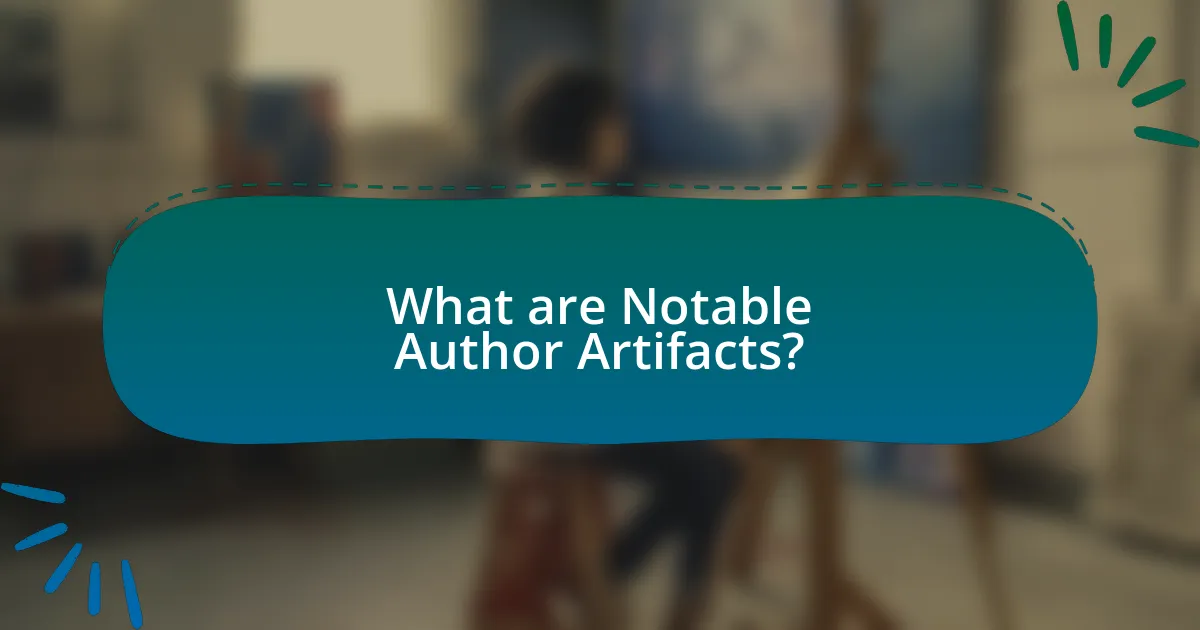Notable author artifacts are personal items and works linked to significant authors, providing insights into their lives, creative processes, and historical contexts. These artifacts, which include manuscripts, letters, photographs, and personal belongings, serve as tangible connections to the authors’ experiences and influences. The article explores how these artifacts reflect an author’s personal life, the types commonly associated with authors, and their significance in understanding an author’s legacy and creative journey. Additionally, it discusses the methodologies used to study these artifacts, the challenges in their preservation, and practical steps for engaging with them effectively.

What are Notable Author Artifacts?
Notable author artifacts are personal items or works associated with significant authors that provide insights into their lives, creative processes, and historical contexts. These artifacts can include manuscripts, letters, photographs, and personal belongings, which serve as tangible connections to the authors’ experiences and influences. For example, the original manuscripts of classic novels or personal letters exchanged with contemporaries can reveal the author’s thoughts, struggles, and relationships, thereby enriching our understanding of their literary contributions and the era in which they lived.
How do artifacts reflect an author’s personal life?
Artifacts reflect an author’s personal life by serving as tangible representations of their experiences, beliefs, and emotions. For instance, personal letters, manuscripts, and objects associated with an author can reveal insights into their relationships, struggles, and inspirations. The type of artifacts, such as a writer’s journal or a specific pen used for drafting, can indicate their writing process and creative influences. Historical examples include Virginia Woolf’s diaries, which provide a glimpse into her mental health and social interactions, or Ernest Hemingway’s typewriter, symbolizing his dedication to the craft. These artifacts not only illustrate the author’s life circumstances but also contextualize their literary works within their personal narratives.
What types of artifacts are commonly associated with authors?
Artifacts commonly associated with authors include manuscripts, letters, personal journals, and writing instruments. Manuscripts provide insight into an author’s creative process and revisions, while letters often reveal personal relationships and historical context. Personal journals can offer a glimpse into an author’s thoughts and daily life, and writing instruments, such as pens or typewriters, can reflect the author’s unique style and preferences. These artifacts collectively enhance the understanding of an author’s life and work, illustrating their influences and the environments in which they created.
How do these artifacts provide insight into an author’s creative process?
Artifacts such as manuscripts, letters, and personal items provide direct insight into an author’s creative process by revealing their thoughts, revisions, and inspirations. For instance, handwritten drafts often show the evolution of ideas, illustrating how an author refines their work over time. Additionally, personal letters can disclose the author’s influences and motivations, offering context about their emotional state and external circumstances during the writing process. Historical examples, like Virginia Woolf’s diaries, demonstrate how her reflections on daily life informed her literary themes, thus showcasing the interplay between personal experience and creative output.
Why are artifacts significant in understanding an author’s legacy?
Artifacts are significant in understanding an author’s legacy because they provide tangible evidence of the author’s life, work, and the context in which they created their literature. These physical items, such as manuscripts, letters, personal belongings, and first editions, offer insights into the author’s thoughts, influences, and the historical period they lived in. For instance, the original manuscripts of classic works can reveal changes in the author’s writing process and thematic development, while personal letters can illuminate their relationships and social interactions. Such artifacts serve as primary sources that enrich literary analysis and enhance our comprehension of the author’s impact on culture and society.
What role do artifacts play in literary history?
Artifacts play a crucial role in literary history by providing tangible evidence of an author’s life, creative process, and cultural context. These physical items, such as manuscripts, letters, and personal belongings, offer insights into the historical and social influences that shaped an author’s work. For example, the discovery of Virginia Woolf’s diaries has illuminated her thoughts on gender and modernism, enhancing our understanding of her literary contributions. Such artifacts not only enrich literary scholarship but also connect readers to the personal experiences of authors, making their works more relatable and grounded in reality.
How can artifacts influence the interpretation of an author’s work?
Artifacts can significantly influence the interpretation of an author’s work by providing tangible context that enhances understanding of their life and creative process. For instance, personal letters, manuscripts, and objects related to an author can reveal their thoughts, emotions, and circumstances during the time of writing, which may not be evident in the text alone. Historical examples include the discovery of Virginia Woolf’s diaries, which offered insights into her mental state and the societal pressures she faced, thereby enriching the interpretation of her novels. Such artifacts serve as primary sources that can validate or challenge existing interpretations, allowing scholars and readers to form a more nuanced understanding of the author’s intentions and the themes present in their work.

What can we learn from specific author artifacts?
Specific author artifacts provide insights into the personal lives, creative processes, and historical contexts of the authors. For instance, letters, manuscripts, and personal belongings can reveal an author’s thoughts, struggles, and influences, thereby enhancing our understanding of their literary works. An example is the collection of letters by Virginia Woolf, which illustrates her mental health challenges and relationships, offering a deeper comprehension of her novels. Such artifacts serve as tangible connections to the authors, allowing scholars and readers to explore the interplay between an author’s life experiences and their literary output.
How do personal letters reveal an author’s relationships?
Personal letters reveal an author’s relationships by providing intimate insights into their emotional connections, social interactions, and personal experiences. These letters often contain candid expressions of affection, conflict, and support, illustrating the dynamics between the author and their correspondents. For instance, the correspondence between Virginia Woolf and Vanessa Bell showcases their deep familial bond, while the letters of Ernest Hemingway reveal complex relationships with friends and romantic partners, highlighting themes of loyalty and betrayal. Such correspondence serves as primary sources that document the author’s social circles and emotional landscapes, offering a nuanced understanding of their interpersonal relationships.
What themes can be identified in an author’s correspondence?
Themes identified in an author’s correspondence often include personal relationships, creative processes, social and political commentary, and reflections on identity. Personal relationships are frequently explored through letters that reveal emotional connections, conflicts, and support systems, as seen in the correspondence of authors like Virginia Woolf and her friends. Creative processes are highlighted in discussions about writing techniques, inspirations, and struggles, evident in the letters of Franz Kafka, where he articulates his artistic dilemmas. Social and political commentary emerges as authors respond to contemporary events, such as the letters of George Orwell, which reflect his views on totalitarianism. Lastly, reflections on identity can be found in correspondence that delves into the author’s self-perception and societal roles, as illustrated in the letters of James Baldwin, where he navigates issues of race and sexuality. These themes collectively provide insight into the author’s life and the context in which they wrote.
How do letters compare to published works in terms of authenticity?
Letters generally offer a higher level of authenticity compared to published works. This is because letters are often personal, unedited communications that reflect the author’s immediate thoughts and feelings, while published works undergo extensive editing and revision processes that can alter the original intent and context. For instance, letters from authors like Virginia Woolf or Ernest Hemingway provide direct insights into their personal lives and creative processes, revealing unfiltered emotions and ideas that may not appear in their polished publications. This directness contributes to the perception of authenticity in letters, as they capture the author’s voice in a raw and genuine manner.
What insights do manuscripts provide about an author’s writing journey?
Manuscripts provide critical insights into an author’s writing journey by revealing their creative process, revisions, and thematic evolution. These documents often showcase initial drafts, edits, and annotations that illustrate how an author refines their ideas and develops their voice over time. For instance, the manuscripts of famous authors like Virginia Woolf and Ernest Hemingway demonstrate significant changes in narrative style and structure, reflecting their growth and experimentation in writing. Such artifacts serve as tangible evidence of the author’s struggles, breakthroughs, and the historical context in which they wrote, thereby enriching our understanding of their literary contributions.
How do revisions in manuscripts reflect an author’s development?
Revisions in manuscripts reflect an author’s development by showcasing their evolving understanding of narrative structure, character development, and thematic depth. As authors revise, they often refine their voice, clarify their ideas, and enhance the emotional resonance of their work. This iterative process indicates growth in their writing skills and critical thinking abilities. For instance, a study by the University of Southern California found that authors who engage in multiple revisions tend to produce more cohesive and impactful narratives, demonstrating a clear trajectory of improvement in their craft.
What can be learned from the physical condition of manuscripts?
The physical condition of manuscripts reveals insights into their usage, preservation, and historical context. For instance, wear and tear can indicate how frequently a manuscript was handled or read, while signs of damage, such as water stains or insect activity, can provide information about the environmental conditions in which the manuscript was stored. Additionally, the presence of annotations or marginalia can reflect the engagement of previous readers with the text, offering a glimpse into the intellectual history surrounding the manuscript. Such details contribute to understanding the manuscript’s journey through time and its significance in literary history.

How can we analyze the impact of artifacts on literary studies?
Analyzing the impact of artifacts on literary studies involves examining how physical objects associated with authors influence our understanding of their works and lives. Artifacts such as manuscripts, letters, and personal belongings provide tangible connections to authors, revealing insights into their creative processes, historical contexts, and personal experiences. For instance, the examination of Virginia Woolf’s diaries has illuminated her thoughts on gender and mental health, significantly enriching literary criticism surrounding her novels. This analysis is supported by the field of material culture studies, which emphasizes the importance of objects in shaping cultural narratives and understanding authors’ intentions.
What methodologies are used to study author artifacts?
Qualitative analysis and archival research are the primary methodologies used to study author artifacts. Qualitative analysis involves examining the context, significance, and meaning of artifacts, such as letters, manuscripts, and personal belongings, to gain insights into the author’s life and work. Archival research entails accessing historical documents and collections to uncover the provenance and background of these artifacts, providing a deeper understanding of the author’s experiences and influences. These methodologies are validated by numerous studies in literary and historical scholarship that demonstrate how artifacts can illuminate the personal and professional contexts of authors, revealing their motivations and societal impacts.
How do scholars interpret the significance of artifacts in context?
Scholars interpret the significance of artifacts in context by analyzing their historical, cultural, and social relevance to the time and environment in which they were created. This contextual analysis allows scholars to understand how artifacts reflect the values, beliefs, and practices of the society that produced them. For instance, artifacts associated with notable authors, such as personal letters or manuscripts, provide insights into their creative processes and personal lives, revealing how their experiences influenced their literary works. By examining these artifacts within their specific contexts, scholars can draw connections between the material culture and the broader historical narratives, thereby enhancing our understanding of the authors’ contributions to literature and society.
What challenges arise in the preservation of author artifacts?
The preservation of author artifacts faces several challenges, including deterioration due to environmental factors, lack of funding for conservation efforts, and the difficulty of authenticating and cataloging items. Environmental factors such as humidity, temperature fluctuations, and light exposure can lead to physical degradation of materials like paper and ink. Additionally, many institutions struggle with limited budgets, which hampers their ability to implement proper preservation techniques and acquire necessary resources. Furthermore, the authentication and cataloging of artifacts can be complex, as it requires expertise to verify provenance and significance, making it challenging to maintain accurate records and ensure the integrity of the collection.
What practical steps can be taken to engage with author artifacts?
To engage with author artifacts, individuals can participate in exhibitions, attend lectures, and utilize digital archives. Exhibitions often showcase personal items, manuscripts, and letters that provide insights into the author’s life and work. Attending lectures allows for direct interaction with experts who can offer deeper context and analysis of the artifacts. Digital archives, such as those maintained by libraries and universities, provide access to a wealth of primary sources, enabling researchers and enthusiasts to explore the artifacts remotely. These steps facilitate a comprehensive understanding of the author’s contributions and personal experiences, enhancing appreciation for their literary legacy.
How can readers access and explore author artifacts effectively?
Readers can access and explore author artifacts effectively by utilizing digital archives, libraries, and museum collections that specialize in literary history. Many institutions, such as the Library of Congress and the British Library, provide online databases where readers can view manuscripts, letters, and personal items of authors. Additionally, participating in guided tours or workshops offered by literary museums allows for a deeper understanding of the context and significance of these artifacts. Research shows that engaging with primary sources enhances readers’ comprehension of an author’s life and work, as evidenced by studies conducted by the American Historical Association, which highlight the educational benefits of direct interaction with historical materials.
What are best practices for preserving personal artifacts related to authors?
Best practices for preserving personal artifacts related to authors include maintaining a stable environment, using archival materials, and documenting provenance. A stable environment involves controlling temperature and humidity levels to prevent deterioration; for instance, a temperature range of 65-70°F and humidity levels of 30-50% are recommended. Archival materials, such as acid-free boxes and sleeves, protect artifacts from physical damage and chemical degradation. Documenting provenance ensures that the history and significance of each artifact are recorded, which aids in future preservation efforts and enhances the artifact’s value. These practices are supported by guidelines from institutions like the American Institute for Conservation, which emphasizes the importance of environmental control and proper handling techniques in artifact preservation.


